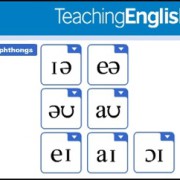The demise of ʊə as in CURE
 In the Titanic tragedy a century ago, the ship broke into several pieces as it sank. Something rather similar can be seen in the demise of the old RP vowel ʊə, which once corresponded to a fairly intact lexical set CURE. We can discern several distinct fates for the members of this set in the contemporary pronunciation of standard southern British English (SSB).
In the Titanic tragedy a century ago, the ship broke into several pieces as it sank. Something rather similar can be seen in the demise of the old RP vowel ʊə, which once corresponded to a fairly intact lexical set CURE. We can discern several distinct fates for the members of this set in the contemporary pronunciation of standard southern British English (SSB).
Fate 1: Merger. CURE syllables which have undergone this fate are merged with other sets: predominantly THOUGHT, but also GOOSE and NURSE.
Fate 2: Varisyllabicity. Like the WIRE and NEAR sets, CURE syllables which have undergone this fate are heard in two forms. Specifically, they are heard both as disyllabic sequences of GOOSE + schwa and as “smoothed” monosyllables.
Fate 3: Monophthonging. Like the SQUARE set, CURE syllables which have undergone this fate are heard as monophthongs. These often sound like the “smoothed” options of the varisyllabic forms.
The first of these fates has been widely discussed, but Fates 2 and 3 have not. As a result, reports of the health of ʊə have been greatly exaggerated. I’ll now discuss the three Fates in turn.
Fate 1: Merger
The merger of CURE words into other lexical sets has been going on for a long time in different parts of England. There are progressive accents, such as my own “educated Northern” accent, in which practically all the traditional CURE words belong to the THOUGHT set. In these accents, your, sure, poor, tour, cure and pure all rhyme with bore and law, during rhymes with boring and jury with story. Such pronunciations are not stigmatized, and the sheer simplicity of this system certainly counts in its favour as a model for learners, especially as the contemporary THOUGHT vowel has the same quality as the o of so many languages.
In the south of England, more and more CURE words have defected to THOUGHT over the past century. Already in 1918’s Outline of English Phonetics, Daniel Jones acknowledged that
it is by no means uncommon to hear poor, sure pronounced as poə, ʃoə, pɔə, ʃɔə or even pɔː, ʃɔː… the forms with ɔə and ɔː are not recommended for foreigners. Footnote: Except in the case of the single word your, which is generally pronounced jɔː or jɔə
As part of her 2006 doctoral dissertation, Bente Hannisdal of Bergen University counted the CURE tokens which had merged into THOUGHT in the speech of British TV newsreaders. Words that were mainly or exclusively pronounced with the THOUGHT vowel included your, you’re, poor, sure (and related forms such as ensure and reassure), endure, moor, tour and tournament. Words which in her conservatively-defined corpus were resistant to THOUGHT-merger included bureau, cure, secur(ity), during, Euro(pe), fury, jury, rural and tourist.
But the word cure itself is now so commonly merged that it no longer makes a sensible keyword for the dwindling lexical set; PURE or matURE would probably be better. Here, for example, is cure as kjoː in the Cambridge online dictionary:
However, dictionaries tend to be behind the times with their transcriptions: that Cambridge kjoː is not transcribed with the THOUGHT vowel, but rather is accompanied by the old RP-style transcription kjʊə. Likewise the online Oxford Advanced Learner’s dictionary transcribes insecure as ˌɪnsɪˈkjʊə but the audio, again, exhibits THOUGHT-merger:
For some speakers, some CURE words have merged not into THOUGHT but into NURSE or GOOSE. According to the opinion polls in John Wells’s Longman Pronunciation Dictionary, words such as during, jury and lure are merged by some speakers into THOUGHT and by some others into NURSE. So jury may rhyme with story for some speakers and with furry for some others.
Such NURSE-merger of CURE words is widespread in rhotic American English, though again the dictionary transcriptions seem somewhat conservative about this. Neither LPD nor the online dictionaries of Oxford, Cambridge or Macmillan give NURSE-merger as an American option for secure, but it’s very common, and clearly the basis for a rhyme in this series of picture ads for PayPal:
 I haven’t heard/seen any audio/video versions of these ads, but they’re presumably American-produced. Anyway, NURSE-merger is not a common fate for CURE syllables in Britain. Hannisdal reports no NURSE realizations in her entire newsreader corpus.
I haven’t heard/seen any audio/video versions of these ads, but they’re presumably American-produced. Anyway, NURSE-merger is not a common fate for CURE syllables in Britain. Hannisdal reports no NURSE realizations in her entire newsreader corpus.
GOOSE-merger seems much more common. It’s an option when followed by r + vowel, and is precisely analogous to the optional change of WIRE to PRICE and of SOUR to MOUTH. For instance, the online Oxford Advanced Learner’s dictionary transcribes fiery and floury with WIRE and SOUR: ˈfaɪəri and ˈflaʊəri; whereas the online Macmillan dictionary transcribes them with PRICE and MOUTH: ˈfaɪri and ˈflaʊri. Similarly, the online Cambridge entry for tourist sounds like two-wrist:
(Unsurprisingly, the accompanying transcription is not ˈtuː.rɪst but the conservative ˈtʊə.rɪst.)
And here is Prof. Jim Al-Khalili saying curious and inquiring mind, in which the first syllable of curious is like cue/queue:
Hannisdal seems to agree that GOOSE-merger is very common:
In words like Europe, rural and tourist, where the /r/ is present, the vowel tends to be realised as a monophthong by the speakers in the present study. This monophthong may be interpreted as a variant of /uː/ [my emphasis] (p. 152)
It’s important to note that words of this form make up the great majority of the CURE tokens in Hannisdal’s study. I certainly agree that words like Europe, rural and tourist are practically never heard with a centring diphthong, not even from conservative-sounding newsreaders. But although Hannisdal says that this predominant pronunciation may be considered “a variant of /uː/”, i.e. merged with GOOSE, she seems not to have counted any of these tokens as such. On the contrary, she somewhat misleadingly classifies anything not merged with THOUGHT as a survival of the old RP “/ʊə/”.
Fate 2: Varisyllabicity
Varisyllabicity, which I discussed in a previous post, is widely exhibited by the WIRE, NEAR and SOUR sets. These may be analyzed, respectively, as PRICE + ə, FLEECE + ə and MOUTH + ə. They occur either in these full, two-syllable forms, or alternatively “smoothed” and “compressed” into monosyllabic forms ɑː or ɑə, ɪː or ɪə, aː or aə. The smoothed, monosyllabic forms are more common when further syllables occur within the word.
Similarly, some members of the traditional CURE set are heard in a two-syllable form comprising GOOSE + ə, particularly when no further syllables occur within the word. To illustrate varisyllabicity, here are pairs of words in which the first members sound disyllabic while the second members, in which further syllables follow within the word, exhibit smoothed-and-compressed monosyllabic variants. First, from the online Cambridge dictionary, retire and retirement; second, from the same source, near and nearly; third, from the online Macmillan dictionary, secure and security:
The Oxford Advanced dictionary has a similarly varisyllabic secure:
We already heard a disyllabic-sounding Cure in the very first clip of this post, when the speaker referred to The Cure on tour. Here also is Gavin Hewitt, BBC News’s Europe Editor, saying French people are very insecure, with a disyllabic-sounding –ure in insecure:
If we compare secure and skewer from the Macmillan dictionary, the words seem very like a rhyming pair, even though they are transcribed as sɪˈkjʊə and ˈskjuːə respectively. And crudely splicing the sk- of skewer to the -ure of secure produces a perfectly natural-sounding rendition of skewer:
(In my previous post on varisyllabicity, I used evidence from musical word-setting to show that WIRE and NEAR words function varisyllabically. Unfortunately it’s hard to come by musical instances of disyllabic CURE words, probably because the lexical set itself is small and contains relatively few words likely to occur in lyrics, and songwriters and singers may well have less conservative accents and therefore more THOUGHT-merger.)
Note that the smooth CURE of security in both the Macmillan and Oxford dictionaries is not only monosyllabic but also monophthongal – there is only one vowel target between the j and the ɹ. In another post, I suggest that the structure on which smoothing operates is a sequence of a diphthong plus ə. If we recognize that the GOOSE vowel is a diphthong (and I think we should), then smoothing applies straightforwardly in cases like the Macmillan/Oxford secure ~ security. If GOOSE is analyzed as, say, ɵw, then ɵw + ə may be smoothed to ɵː, which matches well what we hear from many speakers.
Note also that Hannisdal’s dissertation, unless I’ve missed something, doesn’t even consider the varisyllabic option. We saw above that, by her own admission, a very large proportion of the CURE tokens in her corpus were monophthongs. Many others may well have been disyllabic. But any such forms presumably would have been counted as survivals of the RP “/ʊə/ phoneme”.
So far we’ve looked at two of the common ways in which the centring diphthong ʊə has vanished from SSB speech. There are speakers (like me) for whom the entire CURE set has undergone Fate 1 (merger), and also many speakers for whom some CURE words have undergone Fate 1 while others have undergone Fate 2 (varisyllabicity). It’s important to note that if all CURE forms are considered to have undergone either Fate 1 or Fate 2, then there is no longer any need for a distinctive CURE vowel. Fate 1 simply reassigns CURE forms to the THOUGHT set, or to GOOSE, or even to NURSE. Fate 2, on the other hand, reanalyzes CURE forms as sequences of GOOSE + ə, just as varisyllabic WIRE forms can be analyzed as PRICE + ə.
Whether one teaches a totally merged system (the simplest option) or both merged and varisyllabic forms, there’s an advantage for new learners in omitting an unnecessary vowel from the large and challenging inventory of English. This was evidently the view of TeachingEnglish, the online resource sponsored by the British Council and the BBC. Their “new British Council phonemic chart” (Dec 2010), the diphthong section of which is pictured at the top of this post, dispensed with ʊə altogether.
Needless to say, it wasn’t long before users of the TeachingEnglish site had pointed out the “error”, to which Rob Lewis of the TE Team replied:
the missing diphthong you mention was the subject of much debate in our team – to include it or not to include it. Although its use is in decline, you can still hear it in the UK (and elsewhere?). We may well revise this chart next year to include it.
And by April 2011 Mr. Lewis had posted a capitulatory promise to reinstate the RP diphthong, though the chart hasn’t been changed on the website at the time of my writing this post.
Despite the pedagogical advantages of omitting a distinctive CURE vowel, there remains the question to what extent contemporary standard BrE speakers still have one. Are there members of the CURE set which, for some contemporary speakers, are still neither merged into THOUGHT/GOOSE/NURSE nor varisyllabic? This brings us to Fate 3, the widespread but under-reported monophthonging of CURE.
Fate 3: Monophthonging
First let’s listen to a survival of the RP CURE diphthong. Here is the BBC’s Jeremy Paxman saying poor with what sounds like a genuine old-fashioned [ʊə] (though even this might possibly be disyllabic):
That pronunciation belongs on the endangered-species list: in Hannisdal’s conservative newsreader corpus six years ago, all twenty tokens of poor had merged with THOUGHT. Such [ʊə] pronunciations are now rare in final position and practically extinct before prevocalic ɹ.
Far more common today – for those speakers who haven’t switched all their CURE words to THOUGHT/GOOSE/NURSE or to GOOSE + ə – is a monophthongal realization, with a rounded central quality which can be transcribed as [ɵː]. Here is a series of illustrations. First, Stephen Fry saying insecure; then Prime Minister David Cameron saying secure supplies; then Shadow Business Secretary Chuka Umunna saying so long as these stories endure; then BBC reporter Elise Wicker saying cure seekers and cure a variety; next, a TV interviewee saying to cure my heart condition; then singer Frank Turner, performing the folk song Barbara Allen with the line one kiss from you would cure me:
A less rounded monophthong comes from the Mumsnet website, “the UK’s busiest social network for parents”. This features educational resources sponsored by Pearson (of LPD fame), including a chart of “the 44 phonic sounds“. These are grapheme-sound pairings used in teaching children to read and write, such as “qu” as in quack, corresponding to kw, and “air” as in fair, corresponding to the SQUARE vowel. Audio illustrations are performed by what sounds like a professional actor. The last item on the chart is “ure” as in pure:
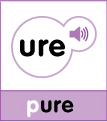
Clearly this is j followed by a long monophthong. The monophthong sounds similar to NURSE but is distinct from it, since the speaker’s “ur/er” as in fern is clearly more front and open:
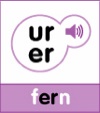
The monophthongal nature of this contemporary CURE monophthong is visible in spectrograms. First, for comparison, here are two non-monophthongal pronunciations – Macmillan’s secure with GOOSE + schwa, and Paxman’s old-fashioned poor. In both we can clearly see the rising second formant (F2) corresponding to the glide from a relatively back rounded quality towards schwa:
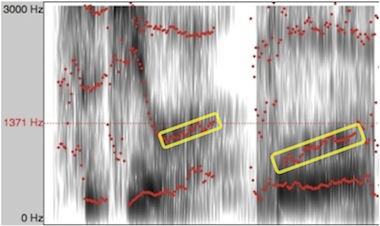
Now some of the monophthongs. Here is the syllable cure from Stephen Fry, David Cameron and the interviewee, and the less rounded ure from Mumsnet. In each case the sharp descent of F2 for j is followed by strikingly flat formants which confirm the unchanging quality of this contemporary CURE vowel:
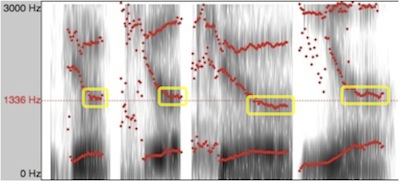
So, for speakers who retain in some words a CURE vowel that is neither THOUGHT/GOOSE/NURSE nor varisyllabic, this residual CURE vowel has monophthonged since RP, much like the SQUARE vowel. SQUARE has shifted from eə to ɛː, while residual CURE has shifted from ʊə to ɵː.
Hannisdal says of her CURE results:
The analysis of CURE lowering [= THOUGHT-merger] shows that both /ʊə/ and /ɔː/ are used in CURE, but the centring diphthong is three times as frequent as the monophthong [my emphasis]
We can now see how simplistic and misleading this is. Ironically, the phonetic context which provides most of Hannisdal’s THOUGHT-resistant tokens – namely before prevocalic ɹ – is precisely the context in which a monophthong is most likely to occur. Of her 952 so-called “/ʊə/” tokens, 819 (86%) were instances of the words during, Euro, Europe, European, security and tourist. As Hannisdal herself admits, most of these can be considered GOOSE tokens. It’s likely that others contained varisyllabic GOOSE + ə, and that still others contained the contemporary CURE monophthong: CURE pronounced with a true centring diphthong ʊə was almost certainly a rarity in her database. And of course many speakers have far more extensive THOUGHT-merger than these conservatively-selected newsreaders – including, as we’ve heard, speakers for the Oxford and Cambridge dictionaries. Surely, old ʊə is proving to be non-durable in standard speech.
So I think that the reinstating of ʊə on the TeachingEnglish website would be a step backwards in several senses. A distinctive CURE vowel is not needed pedagogically. Omitting it reduces the number of vowels to be taught. In addition, I think it’s better that learners should pronounce pure and Europe with THOUGHT – as I often hear them said by SSB speakers – than that learners should be led to pronounce a diphthong (which for many is likely to be ua) in sure, your, poor, Europe, tourist and jury. And to the extent that a distinctive residual CURE vowel is needed for a full description of contemporary speech, it is generally (like SQUARE) a monophthong – not ʊə at all.
It’s a messy demise, but clearly part of what Hannisdal describes as “a more general trend, whereby RP centring diphthongs are being replaced by monophthongs” (p. 99). (In my opinion, TeachingEnglish should also jettison ɪə, and shift eə over to the monophthongs.) The CURE mess is the kind we make at home in the process of a clear-out: overall, the system is simplifying. But until/unless the CURE residue is considered gone, “ure” is liable to present problems.
These problems were demonstrated to comic effect a generation ago when Scottish rock star Midge Ure appeared, as himself, on the TV sitcom Filthy, Rich and Catflap. Ure’s family name is not uncommon in Scotland, where it has the fairly straightforward and unremarkable pronunciation jʉr, like your or you’re. But for non-rhotic southern Brits, it’s disastrously unfamiliar. Setting aside the question of whether to pronounce it with an initial j (as in Uruguay but not in Urdu), what is one to do with the vowel? Back in the 1980s the possibility of using a monosyllabic diphthong ʊə would have been stronger than now, but even then it was a relatively conservative option. Alternatively, there’s the possibility of THOUGHT merger. This is the choice of the Englishwoman who contributed this pronunciation of Midge Ure to www.forvo.com (“All the words in the world. Pronounced.”):
There is also some possibility of NURSE merger. And there’s the possibility of varisyllabicity, i.e. analyzing Ure as GOOSE + ə. This is the choice of the Englishman who contributed this disyllabic-sounding pronunciation of Ian Ure (a Scottish footballer of the 1960s) to www.forvo.com:
Then there’s the possibility of smoothing a varisyllabic Ure into a monosyllabic form. As I outlined in my post on varisyllabicity, this can be done in one of two ways, producing either a centring variant or a monophthongal variant. If, for instance, the input GOOSE + ə is analyzed as ɵwə, this can produce either ɵə or ɵː.
Finally, there’s the possibility of a distinctive monosyllabic monophthong, which itself varies phonetically from the Stephen Fry variety to the type illustrated on the Mumsnet site.
Even 25 years ago, it certainly wasn’t Hannisdal’s simple two-way choice between “/ʊə/ and /ɔː/”. And for comic actor Rik Mayall, appearing on the sitcom with Ure, the chaos of this disintegrating vowel was the pretext for a running gag (in more than one sense) on its unpronounceability:


